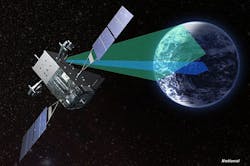IARPA asks industry for ability to image geosynchronous objects for space situational awareness
Officials of the U.S. Intelligence Advanced Research Projects Agency (IARPA) in Washington from 9 a.m. to 3 p.m. eastern time on 11 May 2017 at yet-to-be determined location in the Washington, D.C. area, on the upcoming Amon-Hen program to produce images of objects in geosynchronous orbit, which is 22,236 miles above the Earth's surface.
IARPA's Amon-Hen program seeks to develop ground-based GEO imaging that enables rapid collection of data for inteferometric image reconstruction of geosynchronous objects at low cost.
The name Amon-Hen, taken from the J.R.R. Tolkien Lord Of The Rings novel trilogy, refers to a significant lookout post that watches over the city of Gondor in the fictional world of Middle-earth.
One potential technology approach to the Amon-Hen project is to use a large number of small apertures, IARPA officials say. In addition to reducing costs, small aperture could enable simultaneous measurements at a large number of baselines, reducing acquisition timelines and increasing the number of geosynchronous objects imaged in one night.
Related: Boeing to help Air Force develop space superiority technologies for the control of space
The goal of the Amon-Hen program is to develop a low-cost, passive, ground-based, optical interferometer that from the ground can resolve images in geosynchronous orbit to 12.5 nanoradian angular resolution, and then convert one night's imaging data to a final image.
Imaging data from one geosynchronous object must be completed in less than one hour. Image interpretability must be equivalent to Space Object Rating Scale (SORS) Level 6 or better.
Geosynchronous orbit is of particular interest to U.S. intelligence experts because it is the altitude at which orbiting remote-sensing satellites maintain the same position above the Earth's surface; the Earth does not rotate underneath the spacecraft as it does with satellites orbiting at lower altitudes.
As more nations become active in space, U.S. intelligence agencies have an increasing need for space situational awareness -- particularly timely information about systems and activities in geosynchronous Earth orbit, IARPA officials explain.
The U.S. Senate Armed Services Committee has identified the need to develop ground-based capabilities for passive imagery of geosynchronous objects to provide a credible layer of accountability for behavior in space.
Related: Situational awareness relies on data communications and networking
Since objects in geosynchronous orbit are 22,236 miles above the Earth's surface, these objects appear from the ground to be so small and dim that telescopic observation cannot provide imagery of sufficient resolution for the space situational awareness needs of the military and intelligence community, IARPA officials say. The altitude of geosynchronous orbit is nearly three times the diameter of Earth.
Different ground-based approaches to image geosynchronous objects have focused on interferometers such as the Naval Precision Optical Interferometer (NPOI) and the Magdalena Ridge Optical Interferometer (MROI), both of which have active research programs in geosynchronous imaging.
Because geosynchronous objects are dim, however, finding and measuring the interference fringes developed between any two apertures in the interferometer is challenging, IARPA officials say.
The complex shape of geosynchronous objects also reduces inherent signal strength in the fringes resulting in a fringe tracking and fringe measurement problem that rapidly becomes more difficult at longer interferometer baselines necessary for high-resolution image reconstruction.
Previous attempts have involved several design approaches using relatively large apertures of one to two meters in diameter. Even with such large apertures, however, taking enough baseline measurements for image reconstruction in a reasonably short period of time leads to prohibitively high system costs.
The upcoming Amon-Hen project will try to overcome many of these challenges. IARPA will release a formal solicitation with more details around early May.
Companies interested in attending the Amon-Hen industry briefings on 11 May 2017 should register online no later than 4 May 2017 at https://eventmanagement.cvent.com/AMON-HENPD. Those registering will receive email directions to the briefing location. Only U.S. citizens may attend.
Email questions or concerns to IARPA's Merrick DeWitt at [email protected]. More information is online at https://www.fbo.gov/notices/5327a4fdba9bf3b451594850c8861422.
Learn more: search the Aerospace & Defense Buyer's Guide for companies, new products, press releases, and videos
